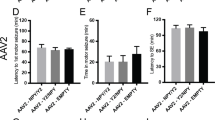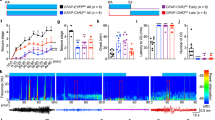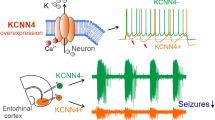Abstract
Astrocytes are an attractive cell target for gene therapy, but the validation of new therapeutic candidates is needed. We determined whether adeno-associated viral (AAV) vector-mediated overexpression of glutamine synthetase (GS) or excitatory amino-acid transporter 2 (EAAT2), or expression of microRNA targeting adenosine kinase (miR-ADK) in hippocampal astrocytes in the rat brain could modulate susceptibility to kainate-induced seizures and neuronal cell loss. Transgene expression was found predominantly in astrocytes following direct injection of glial-targeting AAV9 vectors by 3 weeks postinjection. ADK expression in miR-ADK vector-injected rats was reduced by 94–96% and was associated with an ~50% reduction in the duration of kainate-induced seizures and greater protection of dentate hilar neurons but not CA3 neurons compared with miR-control vector-injected rats. In contrast, infusion of AAV-GS and EAAT2 vectors did not afford any protection against seizures or neuronal damage as the level of transcriptional activity of the glial fibrillary acidic promoter was too low to drive any significant increase in transgenic GS or EAAT2 relative to the high endogenous levels of these proteins. Our findings support ADK as a prime therapeutic target for gene therapy of temporal lobe epilepsy and suggest that alternative approaches including the use of stronger glial promoters are needed to increase transgenic GS and EAAT2 expression to levels that may be required to affect seizure induction and propagation.
This is a preview of subscription content, access via your institution
Access options
Subscribe to this journal
Receive 12 print issues and online access
$259.00 per year
only $21.58 per issue
Buy this article
- Purchase on Springer Link
- Instant access to full article PDF
Prices may be subject to local taxes which are calculated during checkout





Similar content being viewed by others
Accession codes
References
Gelfand Y, Kaplitt MG . Gene therapy for psychiatric disorders. World Neurosurg 2013; 80: S32 e11–e18.
Simonato M, Bennett J, Boulis NM, Castro MG, Fink DJ, Goins WF et al. Progress in gene therapy for neurological disorders. Nat Rev Neurol 2013; 9: 277–291.
LeWitt PA, Rezai AR, Leehey MA, Ojemann SG, Flaherty AW, Eskandar EN et al. AAV2-GAD gene therapy for advanced Parkinson's disease: a double-blind, sham-surgery controlled, randomised trial. Lancet Neurol 2011; 10: 309–319.
Eberling JL, Jagust WJ, Christine CW, Starr P, Larson P, Bankiewicz KS et al. Results from a phase I safety trial of hAADC gene therapy for Parkinson disease. Neurology 2008; 70: 1980–1983.
Christine CW, Starr PA, Larson PS, Eberling JL, Jagust WJ, Hawkins RA et al. Safety and tolerability of putaminal AADC gene therapy for Parkinson disease. Neurology 2009; 73: 1662–1669.
Leone P, Shera D, McPhee SW, Francis JS, Kolodny EH, Bilaniuk LT et al. Long-term follow-up after gene therapy for canavan disease. Sci Transl Med 2012; 4: 165ra163.
Cannon JR, Sew T, Montero L, Burton EA, Greenamyre JT . Pseudotype-dependent lentiviral transduction of astrocytes or neurons in the rat substantia nigra. Exp Neurol 2011; 228: 41–52.
Drinkut A, Tereshchenko Y, Schulz JB, Bahr M, Kugler S . Efficient gene therapy for Parkinson’s disease using astrocytes as hosts for localized neurotrophic factor delivery. Mol Ther 2012; 20: 534–543.
Lawlor PA, Bland RJ, Mouravlev A, Young D, During MJ . Efficient gene delivery and selective transduction of glial cells in the mammalian brain by AAV serotypes isolated from nonhuman primates. Mol Ther 2009; 17: 1692–1702.
Weinberg MS, Blake BL, Samulski RJ, McCown TJ . The influence of epileptic neuropathology and prior peripheral immunity on CNS transduction by rAAV2 and rAAV5. Gene Therapy 2011; 18: 961–968.
Seifert G, Schilling K, Steinhauser C . Astrocyte dysfunction in neurological disorders: a molecular perspective. Nat Rev Neurosci 2006; 7: 194–206.
de Lanerolle NC, Kim JH, Williamson A, Spencer SS, Zaveri HP, Eid T et al. A retrospective analysis of hippocampal pathology in human temporal lobe epilepsy: evidence for distinctive patient subcategories. Epilepsia 2003; 44: 677–687.
de Lanerolle NC, Lee TS, Spencer DD . Histopathology of human epilepsy. In: Noebels JL, Avoli M, Rogawski MA, Olsen RW, Delgado-Escueta AV (eds). Jasper's Basic Mechanisms of the Epilepsies, 4th edn. Bethesda, MD, USA, 2012.
Binder DK, Steinhauser C . Functional changes in astroglial cells in epilepsy. Glia 2006; 54: 358–368.
Wetherington J, Serrano G, Dingledine R . Astrocytes in the epileptic brain. Neuron 2008; 58: 168–178.
During MJ, Spencer DD . Extracellular hippocampal glutamate and spontaneous seizure in the conscious human brain. Lancet 1993; 341: 1607–1610.
Chapman AG . Glutamate and epilepsy. J Nutr 2000; 130 (Suppl): 1043S–1045SS.
Rothstein JD, Martin L, Levey AI, Dykes-Hoberg M, Jin L, Wu D et al. Localization of neuronal and glial glutamate transporters. Neuron 1994; 13: 713–725.
Rothstein JD, Dykes-Hoberg M, Pardo CA, Bristol LA, Jin L, Kuncl RW et al. Knockout of glutamate transporters reveals a major role for astroglial transport in excitotoxicity and clearance of glutamate. Neuron 1996; 16: 675–686.
Lehre KP, Levy LM, Ottersen OP, Storm-Mathisen J, Danbolt NC . Differential expression of two glial glutamate transporters in the rat brain: quantitative and immunocytochemical observations. J Neurosci 1995; 15 (Part 1): 1835–1853.
Eid T, Thomas MJ, Spencer DD, Runden-Pran E, Lai JC, Malthankar GV et al. Loss of glutamine synthetase in the human epileptogenic hippocampus: possible mechanism for raised extracellular glutamate in mesial temporal lobe epilepsy. Lancet 2004; 363: 28–37.
Mathern GW, Mendoza D, Lozada A, Pretorius JK, Dehnes Y, Danbolt NC et al. Hippocampal GABA and glutamate transporter immunoreactivity in patients with temporal lobe epilepsy. Neurology 1999; 52: 453–472.
Proper EA, Hoogland G, Kappen SM, Jansen GH, Rensen MG, Schrama LH et al. Distribution of glutamate transporters in the hippocampus of patients with pharmaco-resistant temporal lobe epilepsy. Brain 2002; 125 (Part 1): 32–43.
Tessler S, Danbolt NC, Faull RL, Storm-Mathisen J, Emson PC . Expression of the glutamate transporters in human temporal lobe epilepsy. Neuroscience 1999; 88: 1083–1091.
van der Hel WS, Notenboom RG, Bos IW, van Rijen PC, van Veelen CW, de Graan PN . Reduced glutamine synthetase in hippocampal areas with neuron loss in temporal lobe epilepsy. Neurology 2005; 64: 326–333.
Tanaka K, Watase K, Manabe T, Yamada K, Watanabe M, Takahashi K et al. Epilepsy and exacerbation of brain injury in mice lacking the glutamate transporter GLT-1. Science 1997; 276: 1699–1702.
Demarque M, Villeneuve N, Manent JB, Becq H, Represa A, Ben-Ari Y et al. Glutamate transporters prevent the generation of seizures in the developing rat neocortex. J Neurosci 2004; 24: 3289–3294.
Campbell SL, Hablitz JJ . Glutamate transporters regulate excitability in local networks in rat neocortex. Neuroscience 2004; 127: 625–635.
Wang Y, Zaveri HP, Lee TS, Eid T . The development of recurrent seizures after continuous intrahippocampal infusion of methionine sulfoximine in rats: a video-intracranial electroencephalographic study. Exp Neurol 2009; 220: 293–302.
Boison D . Adenosine augmentation therapy. In: Noebels JL, Avoli M, Rogawski MA, Olsen RW, Delgado-Escueta AV (eds). Jasper's Basic Mechanisms of the Epilepsies, 4th edn. Bethesda, MD, USA, 2012.
Dragunow M . Purinergic mechanisms in epilepsy. Progr Neurobiol 1988; 31: 85–108.
During MJ, Spencer DD . Adenosine: a potential mediator of seizure arrest and postictal refractoriness. Ann Neurol 1992; 32: 618–624.
Li T, Lytle N, Lan JQ, Sandau US, Boison D . Local disruption of glial adenosine homeostasis in mice associates with focal electrographic seizures: a first step in epileptogenesis? Glia 2012; 60: 83–95.
Huber A, Padrun V, Deglon N, Aebischer P, Mohler H, Boison D . Grafts of adenosine-releasing cells suppress seizures in kindling epilepsy. Proc Natl Acad Sci USA 2001; 98: 7611–7616.
Li T, Ren G, Lusardi T, Wilz A, Lan JQ, Iwasato T et al. Adenosine kinase is a target for the prediction and prevention of epileptogenesis in mice. J Clin Invest 2008; 118: 571–582.
Gouder N, Fritschy JM, Boison D . Seizure suppression by adenosine A1 receptor activation in a mouse model of pharmacoresistant epilepsy. Epilepsia 2003; 44: 877–885.
Dunwiddie TV, Worth T . Sedative and anticonvulsant effects of adenosine analogs in mouse and rat. J Pharmacol Exp Therap 1982; 220: 70–76.
Zhang G, Franklin PH, Murray TF . Anticonvulsant effect of N-ethylcarboxamidoadenosine against kainic acid-induced behavioral seizures in the rat prepiriform cortex. Neurosci Lett 1990; 114: 345–350.
Theofilas P, Brar S, Stewart KA, Shen HY, Sandau US, Poulsen D et al. Adenosine kinase as a target for therapeutic antisense strategies in epilepsy. Epilepsia 2011; 52: 589–601.
Foust KD, Nurre E, Montgomery CL, Hernandez A, Chan CM, Kaspar BK . Intravascular AAV9 preferentially targets neonatal neurons and adult astrocytes. Nat Biotechnol 2009; 27: 59–65.
Gray SJ, Matagne V, Bachaboina L, Yadav S, Ojeda SR, Samulski RJ . Preclinical differences of intravascular AAV9 delivery to neurons and glia: a comparative study of adult mice and nonhuman primates. Mol Ther 2011; 19: 1058–1069.
Ogata K, Kosaka T . Structural and quantitative analysis of astrocytes in the mouse hippocampus. Neuroscience 2002; 113: 221–233.
Ben-Ari Y, Cossart R . Kainate, a double agent that generates seizures: two decades of progress. Trends Neurosci 2000; 23: 580–587.
Racine RJ . Modification of seizure activity by electrical stimulation. II. Motor seizure. Electroencephalogr Clin Neurophysiol 1972; 32: 281–294.
Ben-Ari Y . Limbic seizure and brain damage produced by kainic acid: mechanisms and relevance to human temporal lobe epilepsy. Neuroscience 1985; 14: 375–403.
Schmued LC, Hopkins KJ . Fluoro-Jade B: a high affinity fluorescent marker for the localization of neuronal degeneration. Brain Res 2000; 874: 123–130.
Ren G, Li T, Lan JQ, Wilz A, Simon RP, Boison D . Lentiviral RNAi-induced downregulation of adenosine kinase in human mesenchymal stem cell grafts: a novel perspective for seizure control. Exp Neurol 2007; 208: 26–37.
Ortinski PI, Dong J, Mungenast A, Yue C, Takano H, Watson DJ et al. Selective induction of astrocytic gliosis generates deficits in neuronal inhibition. Nat Neurosci 2010; 13: 584–591.
Cearley CN, Vandenberghe LH, Parente MK, Carnish ER, Wilson JM, Wolfe JH . Expanded repertoire of AAV vector serotypes mediate unique patterns of transduction in mouse brain. Mol Ther 2008; 16: 1710–1718.
Cearley CN, Wolfe JH . Transduction characteristics of adeno-associated virus vectors expressing cap serotypes 7, 8, 9, and Rh10 in the mouse brain. Mol Ther 2006; 13: 528–537.
Wu Z, Asokan A, Samulski RJ . Adeno-associated virus serotypes: vector toolkit for human gene therapy. Mol Ther 2006; 14: 316–327.
Li C, Diprimio N, Bowles DE, Hirsch ML, Monahan PE, Asokan A et al. Single amino acid modification of adeno-associated virus capsid changes transduction and humoral immune profiles. J Virol 2012; 86: 7752–7759.
Pulicherla N, Shen S, Yadav S, Debbink K, Govindasamy L, Agbandje-McKenna M et al. Engineering liver-detargeted AAV9 vectors for cardiac and musculoskeletal gene transfer. Mol Ther 2011; 19: 1070–1078.
von Jonquieres G, Mersmann N, Klugmann CB, Harasta AE, Lutz B, Teahan O et al. Glial promoter selectivity following AAV-delivery to the immature brain. PLoS One 2013; 8: e65646.
Xu R, Janson CG, Mastakov M, Lawlor P, Young D, Mouravlev A et al. Quantitative comparison of expression with adeno-associated virus (AAV-2) brain-specific gene cassettes. Gene Therapy 2001; 8: 1323–1332.
Klein RL, Dayton RD, Tatom JB, Henderson KM, Henning PP . AAV8, 9, Rh10, Rh43 vector gene transfer in the rat brain: effects of serotype, promoter and purification method. Mol Ther 2008 16: 89–96.
Su M, Hu H, Lee Y, d'Azzo A, Messing A, Brenner M . Expression specificity of GFAP transgenes. Neurochem Res 2004; 29: 2075–2093.
Colin A, Faideau M, Dufour N, Auregan G, Hassig R, Andrieu T et al. Engineered lentiviral vector targeting astrocytes in vivo. Glia 2009; 57: 667–679.
Xie J, Xie Q, Zhang H, Ameres SL, Hung JH, Su Q et al. MicroRNA-regulated, systemically delivered rAAV9: a step closer to CNS-restricted transgene expression. Mol Ther 2011; 19: 526–535.
Gray SJ, Blake BL, Criswell HE, Nicolson SC, Samulski RJ, McCown TJ et al. Directed evolution of a novel adeno-associated virus (AAV) vector that crosses the seizure-compromised blood–brain barrier (BBB). Mol Ther 2010; 18: 570–578.
Richichi C, Lin EJ, Stefanin D, Colella D, Ravizza T, Grignaschi G et al. Anticonvulsant and antiepileptogenic effects mediated by adeno-associated virus vector neuropeptide Y expression in the rat hippocampus. J Neurosci 2004; 24: 3051–3059.
Noe F, Nissinen J, Pitkanen A, Gobbi M, Sperk G, During M et al. Gene therapy in epilepsy: the focus on NPY. Peptides 2007; 28: 377–383.
Lin EJ, Richichi C, Young D, Baer K, Vezzani A, During MJ . Recombinant AAV-mediated expression of galanin in rat hippocampus suppresses seizure development. Eur J Neurosci 2003; 18: 2087–2092.
Haberman R, Criswell H, Snowdy S, Ming Z, Breese G, Samulski R et al. Therapeutic liabilities of in vivo viral vector tropism: adeno-associated virus vectors, NMDAR1 antisense, and focal seizure sensitivity. Mol Ther 2002; 6: 495–500.
Dragunow M . Adenosine: the brain's natural anticonvulsant. Trends Pharmacol Sci 1986; 7: 128–130.
Dragunow M . Adenosine and seizure termination. Ann Neurol 1991; 29: 575.
Boison D, Scheurer L, Tseng JL, Aebischer P, Mohler H . Seizure suppression in kindled rats by intraventricular grafting of an adenosine releasing synthetic polymer. Exp Neurol 1999; 160: 164–174.
Boison D . Engineered adenosine-releasing cells for epilepsy therapy: human mesenchymal stem cells and human embryonic stem cells. Neurotherapeutics 2009; 6: 278–283.
Cavus I, Kasoff WS, Cassaday MP, Jacob R, Gueorguieva R, Sherwin RS et al. Extracellular metabolites in the cortex and hippocampus of epileptic patients. Ann Neurol 2005; 57: 226–235.
Kanamori K, Ross BD . Chronic electrographic seizure reduces glutamine and elevates glutamate in the extracellular fluid of rat brain. Brain Res 2011; 1371: 180–191.
Su ZZ, Leszczyniecka M, Kang DC, Sarkar D, Chao W, Volsky DJ et al. Insights into glutamate transport regulation in human astrocytes: cloning of the promoter for excitatory amino acid transporter 2 (EAAT2). Proc Natl Acad Sci USA 2003; 100: 1955–1960.
Cahoy JD, Emery B, Kaushal A, Foo LC, Zamanian JL, Christopherson KS et al. A transcriptome database for astrocytes, neurons, and oligodendrocytes: a new resource for understanding brain development and function. J Neurosci 2008; 28: 264–278.
Ciesielska A, Hadaczek P, Mittermeyer G, Zhou S, Wright JF, Bankiewicz KS et al. Cerebral infusion of AAV9 vector-encoding non-self proteins can elicit cell-mediated immune responses. Mol Ther 2013; 21: 158–166.
Kong Q, Takahashi K, Schulte D, Stouffer N, Lin Y, Lin CL . Increased glial glutamate transporter EAAT2 expression reduces epileptogenic processes following pilocarpine-induced status epilepticus. Neurobiol Dis 2012; 47: 145–154.
Otis TS, Jahr CE . Anion currents and predicted glutamate flux through a neuronal glutamate transporter. J Neurosci 1998; 18: 7099–7110.
Brenner M, Kisseberth WC, Su Y, Besnard F, Messing A . GFAP promoter directs astrocyte-specific expression in transgenic mice. J Neurosci 1994; 14 (Part 1): 1030–1037.
Furman JL, Sama DM, Gant JC, Beckett TL, Murphy MP, Bachstetter AD et al. Targeting astrocytes ameliorates neurologic changes in a mouse model of Alzheimer's disease. J Neurosci 2012; 32: 16129–16140.
Lawlor PA, Bland RJ, Das P, Price RW, Holloway V, Smithson L et al. Novel rat Alzheimer's disease models based on AAV-mediated gene transfer to selectively increase hippocampal Abeta levels. Mol Neurodegener 2007; 2: 11.
During MJ, Young D, Baer K, Lawlor P, Klugmann M . Development and optimization of adeno-associated virus vector transfer into the central nervous system. Methods Mol Med 2003; 76: 221–236.
Paxinos G, Watson C . The Rat Brain in Stereotaxic Coordinates2nd ednAcademic Press New York, NY, USA, 1986.
Young D, Lawlor PA, Leone P, Dragunow M, During MJ . Environmental enrichment inhibits spontaneous apoptosis, prevents seizures and is neuroprotective. Nat Med 1999; 5: 448–453.
Petito CK, Chung MC, Verkhovsky LM, Cooper AJ . Brain glutamine synthetase increases following cerebral ischemia in the rat. Brain Res 1992; 569: 275–280.
Acknowledgements
This work was supported by funding from Lottery Health Research (NZ) and the Royal Society of New Zealand Marsden Fund to DY, PAL and MJD, HRC funding to MD, and NIH NINDS RO1 award NS44576 to MJD. We thank M Brenner for providing the 2.2 kb GFAP promoter.
Author information
Authors and Affiliations
Corresponding author
Ethics declarations
Competing interests
The authors declare no conflict of interest.
Additional information
Supplementary Information accompanies this paper on Gene Therapy website
Supplementary information
Rights and permissions
About this article
Cite this article
Young, D., Fong, D., Lawlor, P. et al. Adenosine kinase, glutamine synthetase and EAAT2 as gene therapy targets for temporal lobe epilepsy. Gene Ther 21, 1029–1040 (2014). https://doi.org/10.1038/gt.2014.82
Received:
Revised:
Accepted:
Published:
Issue Date:
DOI: https://doi.org/10.1038/gt.2014.82
This article is cited by
-
Astrocyte-derived SerpinA3N promotes neuroinflammation and epileptic seizures by activating the NF-κB signaling pathway in mice with temporal lobe epilepsy
Journal of Neuroinflammation (2023)
-
The role of excitatory amino acid transporter 2 (EAAT2) in epilepsy and other neurological disorders
Metabolic Brain Disease (2023)
-
Overview Article Astrocytes as Initiators of Epilepsy
Neurochemical Research (2023)
-
Astrocyte-selective AAV gene therapy through the endogenous GFAP promoter results in robust transduction in the rat spinal cord following injury
Gene Therapy (2019)
-
Bioinformatics Analysis of Microarray Profiling Identifies That the miR-203-3p Target Ppp2ca Aggravates Seizure Activity in Mice
Journal of Molecular Neuroscience (2018)



